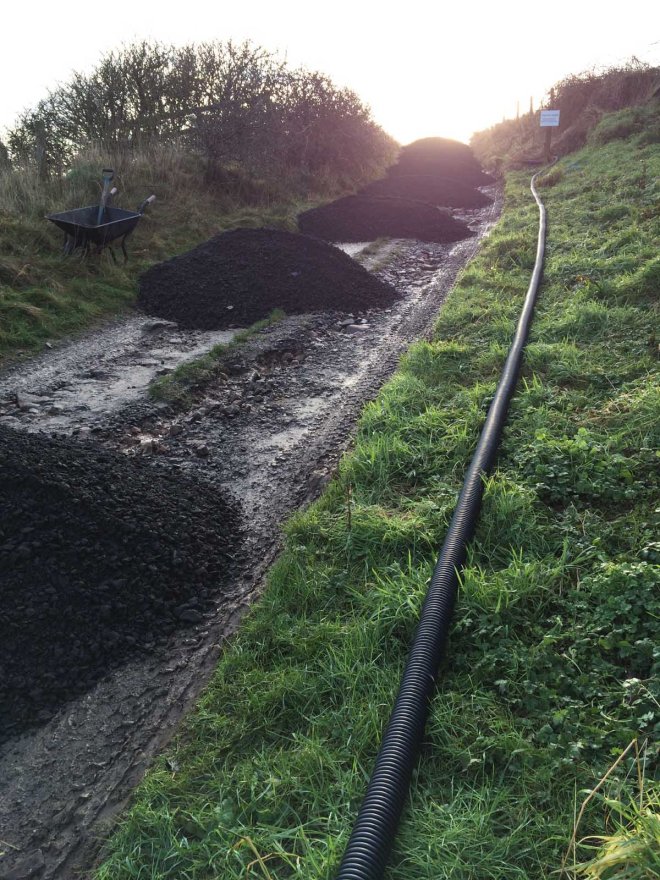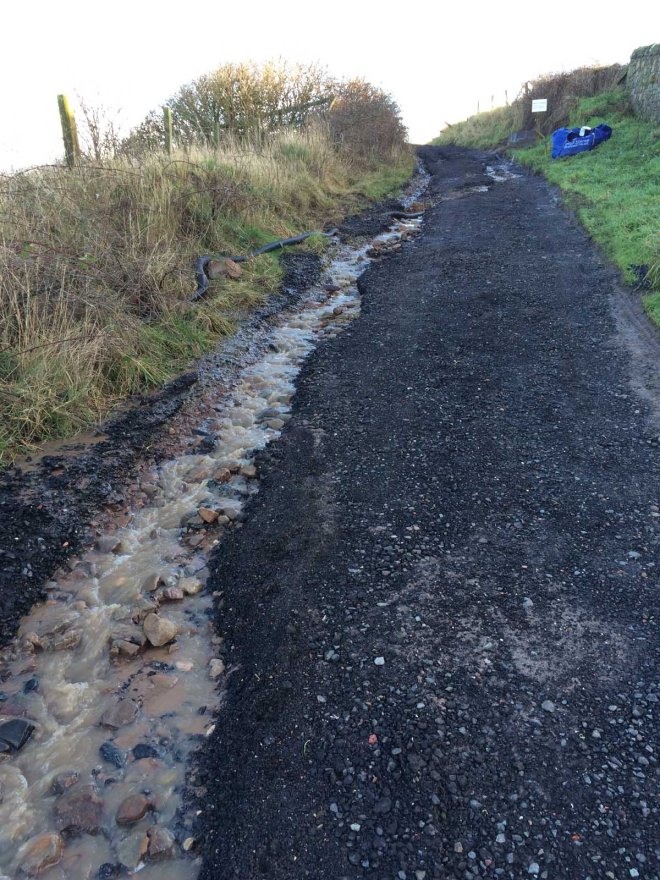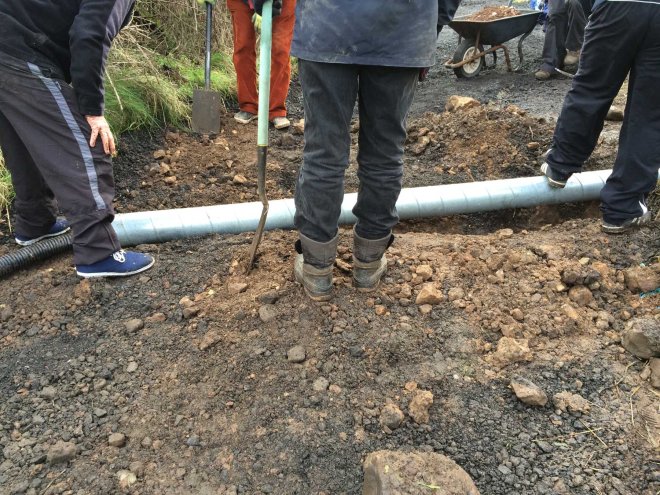We’ve had heavy heavy rain in the UK over the winter – particularly bad in the west of the country with serious floods in Cumbria and Yorkshire. In the North-East we have had nothing to compare with those troubles, thank goodness. But it has caused particular problems with the rough farm track we drive along to get to our house.
The farm track has always been a bit dodgy. But this winter’s lane problems were new. Heavy, heavy rain meant the surrounding fields were waterlogged, with old duck ponds and boundary brooks reappearing. Finally, yet more rain over Christmas meant the land could take no more and water poured off the fields down the only path it could find: our lane.
Deep runnels, pits and channels appeared. The rain continued. The runnels got deeper, the lane more pitted and craggy.
Driving became precarious. Those of our neighbours who had 4-wheel drive came home with confidence. Those with sports cars and low-slung suspension travelled much more cautiously. Our little Suzuki Alto did not like it at all. When temperatures dropped and the water froze, we decided it was far too tricky to drive home, and took to leaving our car in the car park near the sea, at the bottom of the hill. Hard work carrying shopping up from there!
We hit crisis point, and some neighbours decided action must be taken. But it is very complicated because we do not know who owns parts of this lane. Such land ownership problems are not unusual, but ours have a particular history behind them – which is romantic and tragic.
The surrounding farms belong to the Greenwich Hospital Estate – and they used to own our cottage (in the old farm steading) and most of the old cottages about. Yes, we live in the most northern part of Northumberland, just a few miles south of the Scots-English border, and yes, Greenwich Hospital is in East London (some 400 miles away). (You can read more about the Greenwich Hospital and its responsibilities and functions in its 2012-13 annual report here)
Before Greenwich Hospital owned these lands they belonged to the Earls of Derwentwater. Their family home was at Dilston, near Corbridge, in the south of Northumberland. But the Derwentwaters owned large parts of North Northumberland. They were said to be the wealthiest and most powerful Jacobite family in the north of England.
Tragedy struck for the 3rd Earl of Derwentwater, who (a devout Catholic and Jacobite) was one of the leaders of the 1715 Jacobite uprising. The British had deposed their Roman Catholic King with the Glorious Revolution of 1688, and replaced him with his Protestant daughter, Mary, and her Dutch husband, William. But many longed for the return of Roman Catholic Jacobite rule, among them the Earl of Derwentwater.
The rebels were defeated at the battle of Preston, and Derwentwater and the other rebels were captured and taken to London where they were lodged in the Tower of London. Despite the reprieve of some of the other leaders, the King was determined to make an example with the Lords Derwentwater and Kenmure, and they were beheaded on Tower Hill on 24th February 1716. (Below detail of print showing the execution.)
This story of Derwentwater’s fall is told in Devil Water by Anya Seton. She’s a rather forgotten historical novelist these days, but I read – and loved! – all her books when I was young. I re-read Devil Water when we came to live here and there is no doubt her historical research was excellent. Her writing about this area of Northumberland is accurate and evocative.
With his execution, Derwentwater was stripped of his honours and titles, and his estates confiscated. In 1748 the Derwentwater Estates were granted by Act of Parliament to the Royal Hospital at Greenwich.
The Derwentwaters are almost forgotten here, though the odd (mis-spelt!) street sign about still remembers them.
But Greenwich Hospital is still very much part of the area. They continue to manage a Northumberland Estate of 8,000 acres – and that includes the farm fields around us. Their name is also common in the locality.
So how does this tally with our lane problems?! Well, the old farms here were very small – completely impractical for modern farmers – so as farming families came to the end of their leases and moved on, the fields were given to other farms and the houses and buildings sold on. Life has changed so much – in sales of the last century, people didn’t always have their own cars to drive to their home, there were vegetable-growing allotments where modern owners might want enclosed private gardens, and old pathways with habitual rights of way were thought sufficient for new owners.
We know half the lane is co-owned by the four steading cottages at its end. It is the other half – the bad part! – whose ownership is unknown. The cottages alongside have sometimes done some repairs – and Northumberland County Council has even visited recently and made vague encouraging noises.
But we can’t wait for the Council’s deliberations – the track was almost impassable! Initially, a small group of neighbours gathered with a digger and a massive delivery of tarry road chippings, which were helpfully deposited in large piles along the troubled parts of the lane. The idea was to run a pipe across the lane and under the new chippings, channeling the water further down the hill, out of harm’s way.
The idea was to run a pipe across the lane and under the new chippings, channeling the water further down the hill, out of harm’s way. There was just the simple task of spreading the hardcore.
There was just the simple task of spreading the hardcore. I never saw myself working as a navvy …
I never saw myself working as a navvy … Unfortunately – another night’s heavy rain, and all our good work was washed away.
Unfortunately – another night’s heavy rain, and all our good work was washed away. The water completely overwhelmed our nice little pipe arrangement. So much for amateur engineering
The water completely overwhelmed our nice little pipe arrangement. So much for amateur engineering On a recent weekend, an another impromptu neighbourly working party was assembled, pick axes were mounted on unpractised shoulders …
On a recent weekend, an another impromptu neighbourly working party was assembled, pick axes were mounted on unpractised shoulders … trenches were dug …
trenches were dug … – and water was diverted with a new larger pipe! Yeay!
– and water was diverted with a new larger pipe! Yeay! More gravel was spread over the damaged lane …
More gravel was spread over the damaged lane … We haven’t had any serious rain yet to put the working party efforts to the test, but for the moment the lane is passable. At least we can drive home!
We haven’t had any serious rain yet to put the working party efforts to the test, but for the moment the lane is passable. At least we can drive home!
But before I finish this post, I want to return to the story of the Derwentwaters. It was only when I started writing, and checked my facts that I realised the relevance of the date on which James Radclyffe, the 3rd Earl of Derwentwater was executed: 24th February 1716 – by some strange coincidence that’s 400 years ago this week. So, it seems appropriate to mark this anniversary.
What I hadn’t realised was that Derwentwater was only 25 when he found himself the leader of the uprising in 1715 – 26 when he was executed the next year. So very young. According to some accounts he was a very decent man. His contemporary, the Scottish writer, Tobias Smollett, called him “brave, open, generous, hospitable and human.” The Reverend Mr Patten’s description was even more glowing: ” [Derwentwater was] formed by nature to be universally loved for his benevolence was so unbounded that he seemed only to live for others.” (Patten was another contemporary, and the chaplain to the other uprising leader, Thomas Forster).
Fine comments indeed. Some dismiss them saying this was only propaganda by reactionary writers, and actually he was a person of little importance and weak character.
What I can definitively say is that he was brave indeed at his execution. I’m going to quote here some of the very moving description of that event from Christopher Sinclair Stevenson’s book, Inglorious Rebellion:
“At ten o’clock […] he drove in a coach to Tower Hill and then walked through the ranks of
soldiers to the scaffold draped in black. his face was ashen as he mounted the steps to the block, but he retained his calm composure. A few prayers were followed by his speech. It was an extraordinarily moving address in which he retracted his plea of guilty made at his trial, spoke with great warmth and feeling of James III, and assured his audience that the country could have no lasting peace or happiness until the restoration of the Stuarts. His last words were devoid of bitterness: ‘I die a Roman Catholic; I am in perfect charity with all the world, I thank God for it, even with those of the present Government, who are most instrumental in my death. I freely forgive such as ungenerously reported false things of me; and I hope to be forgiven the trespasses of my youth, by the Father of infinite mercy, into his hand I commend my soul.”
His body was taken to Dilston, where he was buried in the family vault.
There’s a nice little accompanying story to his end. Apparently, the Northern Lights were particularly brilliant at the time of his beheading, and in some places they became known as the Earl of Derwentwater’s Lights. As it happens, there have been some fine showings of the Northern Lights in recent days (though we haven’t actually seen them here) – who knows? Perhaps there will be a magnificent replay of the Earl of Derwentwater’s fabulous lights to mark the 400th anniversary of his death …
Whatever, James Radclyffe, 3rd Earl of Derwentwater, RIP. Picture of James Radclyffe, 3rd Earl of Derwentwater reproduced from Wikipedia (public domain)
Picture of James Radclyffe, 3rd Earl of Derwentwater reproduced from Wikipedia (public domain)

Oh my that puts our pothole saga into the shade! Your deeds should say who is responsible for repairs. Suggest you write to the hospital asap.
I love the novels of Anya Seyton . She deserves greater recognition.
Best of luck with repairs.
LikeLike
It’s quite funny – like a particular Monty Python sketch I recall – that our pothole sagas seem to be in competition! Actually, I was appalled to see the large hole you had to deal with. As to our deeds – they say nothing about this particular piece of land, and the same applies to all the other folk who live along the lane. I’ve had similar problems in other places I’ve lived in – they seem to occur when large estates sold off small cottages in the early 20th century. The new ownership details aren’t properly thought through by solicitors used to dealing with large important owners and not the small ordinary people. Glad to hear you liked Anya Seton novels too – time she had a comeback, I think!
LikeLike
Amazing how often history affects modern day living. I wonder how many people know the reason for North Greenwhich Road – it would make me look twice.
I guess in the past, the large estates still looked after the tracks within the estate boundaries even when they sold away individual cottages but nowadays they don’t have the staff or money to take such a benevolent approach.
I’m glad we don’t have to use a road like that in the winter.
LikeLike
I think you are quite right in thinking large estates repaired walls and tracks until recently – we see so much that has gone into decline round us – collapsed walls etc. Sad after generations of care. Yes, our track is a real problem – glad you don’t have one like this!
LikeLike
Thank you kd for such an informative post. I’ll be looking up the books of Anya Seton at the library. I enjoy historical fiction and have finished all the Shardlake novels of CJ Sansom, as well as Hilary Mantel. Do hope you get some road relief!
LikeLike
Glad you enjoyed it, Karen. I did love the Anya Seton books but they are quite old fashioned compared to CJ Sansom and Mantel – wonder what you’ll think of them ?
LikeLike
Your posts are always so informative and interesting! I love how the history is always present! The team work is just amazing – you did great! It reminded me of the post-hurricane weeks when all neighbors were helping each other and figuring out the ways how to improve the current living situation… I hope the rain season is over for you!
LikeLike
Thank you, Alina! I too love the way the past lives with us – it is all around, you only have to look! In an odd sort of way, troubles are quite good for people – they do bring you together – not that I’d wish them on anyone.
LikeLike
Those are extraordinary photographs. I met a Scots woman who said she went to midwifery school in Northunberland. I looked thru the pdf on Greenwich Hosp but couldn’t figure out if it had a midwifery school BUT she is an older woman, sort of like me, and if I see her again I must ask. That is quite is history of the Jacobites, in your back yard!
Thank you.
LikeLike
So glad you liked the pics, Susan. Greenwich Hospital is actually based in London and for retired seafarers – I think your friend probably trained in Newcastle – excellent hospitals there.
LikeLike
The sewer under our local Creek is being replaced after 100 years of population growth. It will take 2 years. After reading this post I am so grateful the council is doing it. I can’t imagine having to dig that out ourselves. Best wishes for some kind of efficient institutional fix for your lane!
LikeLike
We so wish some organisation would repair our lane for us too, Rebecca! When we bought the house, the solicitors got us to take out insurance so that if anybody turned up with proof that they owned the dodgy bits, we could afford to pay to continue using the lane. We never thought that it would disintegrate as it has – but then, I guess, we never thought we’d get all these extreme weather conditions that we’ve all be experiencing! Best – reciprocal – wishes for the happy rebuilding of your local Creek!
LikeLike